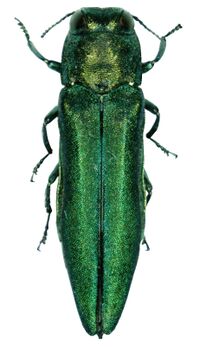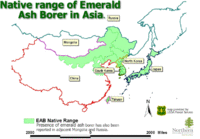Emerald Ash Borer
Also known as Agrilus planipennis or simply EAB the Emerald Ash Borer is a highly invasive species that is devastating Ash populations across North America. The adults are dark green with a metallic appearance and a bright red upper abdomen when its wings are extended; the larvae are white, segmented, flat-headed borers that will go through four larval instars before emerging as adults.
 | |
| Kingdom: | Animalia |
|---|---|
| Phylum: | Arthropoda |
| Class: | Insecta |
| Order: | Coleoptera |
| Family: | Buprestidae |
| Genus: | Agrilus |
| Species: | planipennis |
| Source: | |
Background
The EAB is native to Asia and was first documented in the United States in Southeast Michigan in 2002. It is believed that it was brought here in wooden shipping pallets and other untreated wood products. In its native habitat EAB has several natural predators including multiple species of parasitoid wasps, however in North America there are currently no animals that eat it, however there are studies being done examining the potential role that woodpeckers may have on the species.

Life Cycle
The EAB goes through three major life stages: the larvae, the pupae, and the adult. White eggs are laid with cracks and gaps in the ash tree bark and will turn a red-brown later on. Larvae eat through the bark and begin to develop within the cambium and inner phloem layers of the tree. They will feed on the tree creating long narrow channels within the sapwood, this is the stage when the EAB do the most harm to the trees. After the larvae have fully matured they create a hollow in the outer bark where they fold into a J shape and develop into pupae and eventually adults. Once the EAB have fully matured they eat through the bark leaving a characteristic D shaped hole behind them.

Adults will only emerge after there have been between 400 and 500 consecutive days above 50°F (10°C), and after they have emerged they will eat the leaves from the ash trees for a week prior to mating. On average adults can live for around six weeks and females will lay between 40 and 70 eggs, however some females that live longer can produce up to 200 eggs in their life time. This process can take one or two years, the developing larvae can overwinter inside the trees however this will result in that individual taking an extra year to fully mature.
Effects
The EAB has decimated the Whi